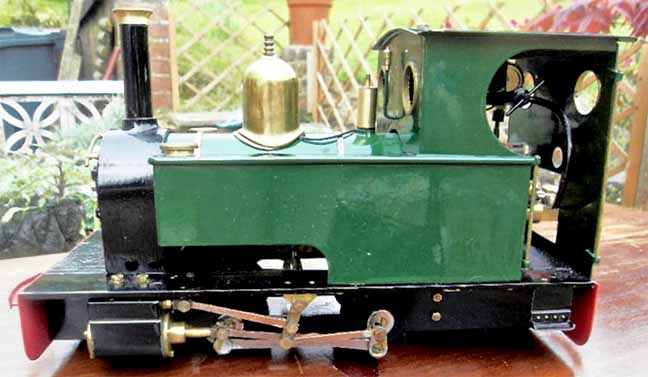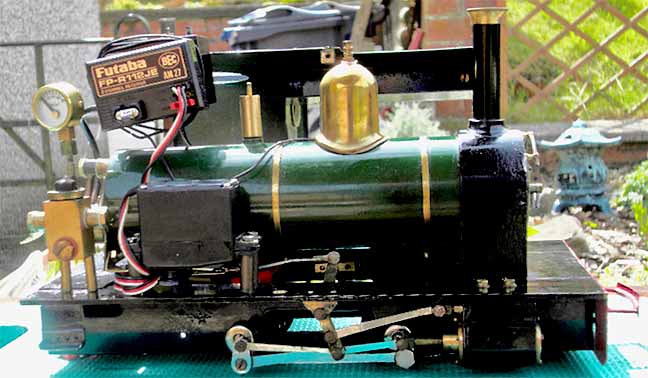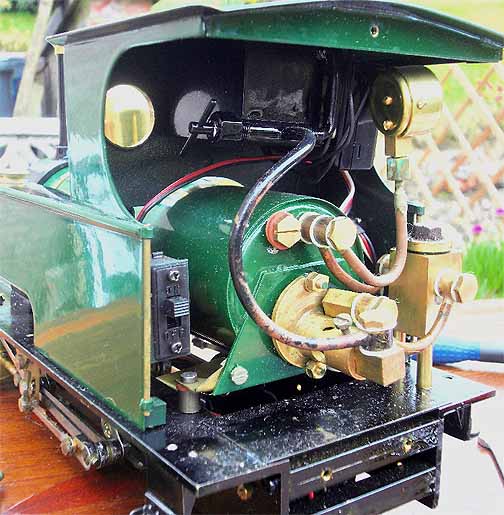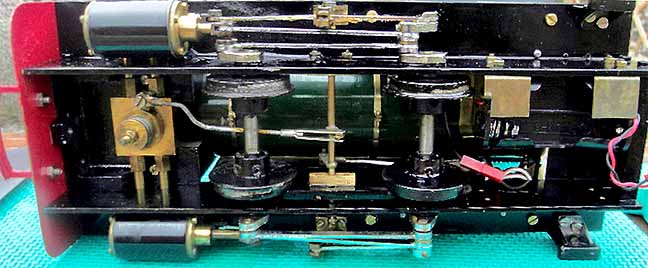Back to Sidestreet Bannerworks
Click here to find out how your engine can be featured!
.


A Merlin "Mayflower"
by Roy Burton
England
Photos by the author
December, 2010
Merlin Beck Engineering Ltd. was a company set up by Tom Cooper. Ian Pearse was in charge of design and general production and, I believe, Donald Pearse, a retired architect, was involved with the production of Merlin's rolling stock.
Back in the late 1970s, as I understand it, Tom Cooper bought out Beck (Germany), the manufacturer of the 0-4-0 ANNA. Using their parts and his own designs, in 1984/5 he introduced the "Mayflower" as one of his midrange entry-level models.
Retailing at around 375 pounds, this model was well received by model live-steam enthusiasts. It was radio controlled and had a copper boiler. Some models were finished to a higher standard than others.
The model
This particular locomotive is mechanically original in every respect and is in excellent running condition, having only been run a few time since it was new in 1985.
The freelance design is loosely based on a British narrow-gauge tank engine. It is an 0-4-0T, regaugeable between 45mm and 32mm. Cylinders are double acting and are controlled by a servo actuated rod between the frames. Forward and reverse motion and speed is controlled by Tom Cooper’s rotary valve .
Batteries are held in place beneath the undercarriage, with an on-off switch nicely placed in the cab for easy excess. There is no sight glass on this particular model but it does have a 3/4"-diameter pressure gauge and a well-designed displacement lubricator (a square brass block), which is easy to fill by removing a screw cap on the top, and a screw plug at the side to release water from the chamber.
To bring this model up to date I have installed a new 2.4 Ghz radio, added a new servo, renewed the control rod, and added a Summerlands Chuffer pipe. I will also be fitting a resonator whistle from DJB Engineering.
On the test bench
To ready the engine, the safety valve is first removed to fill the boiler with water. In the cab there is the displacement lubricator (use steam oil here).
On top of the cab roof is the gas filler valve, a standard Ronson type, which is easy to fill -- simply push down for about 10 seconds to fill. Then a quick oil round of the wheels and con rods.
Turn on the gas at the tank, which is inside the cab above the boiler, next to the radio receiver. Light the gas via the chimney -- it gives a slight pop, then roars into action.
After about 6 minutes steam is raised to about 20-30 psi. In talking with Chris Bird, I understand the actual working pressure is about 40 psi but, as this was a bench test and since the engine had not been run for over 20 years, I actually ran it at about 20 psi.
With steam pressure at 20 psi and the radio switched on, the engine burst into life with no problems at all. I did not even have to clean out the gas jet. The loco ran on test for over 20 minutes before the gas ran out.
Here's a video of the engine in action submitted by Chris Bird. If it doesn't work, click here.
|
|
|
| Builder | Merlin Locomotive Works (England) |
| Date built | 1985 |
| Gauge | 32 mm (gauge 0) |
| Scale | 1:22.5 |
| Boiler | Single flue |
| Fittings | Pressure gauge, safety valve, chuffer pipe, resonator whistle |
| Fuel | Butane gas |
| Blow-off pressure | 45 psi |
| Cylinders | Two, double-acting piston-valve |
| Reversing gear | Rotary valve |
| Lubricator | Displacement |
| Dimensions | Length 12"; width, 4"; stack height, 4-3/4" from the base of the smokebox |
| Weight | 6 lbs. 5 oz. |




Above: With the back sheet in place, the engine has a tidy, finished look about it.

Back to Sidestreet Bannerworks
Click here to find out how your engine can be featured!
This page and its contents
Copyright Sidestreet Bannerworks, 2010